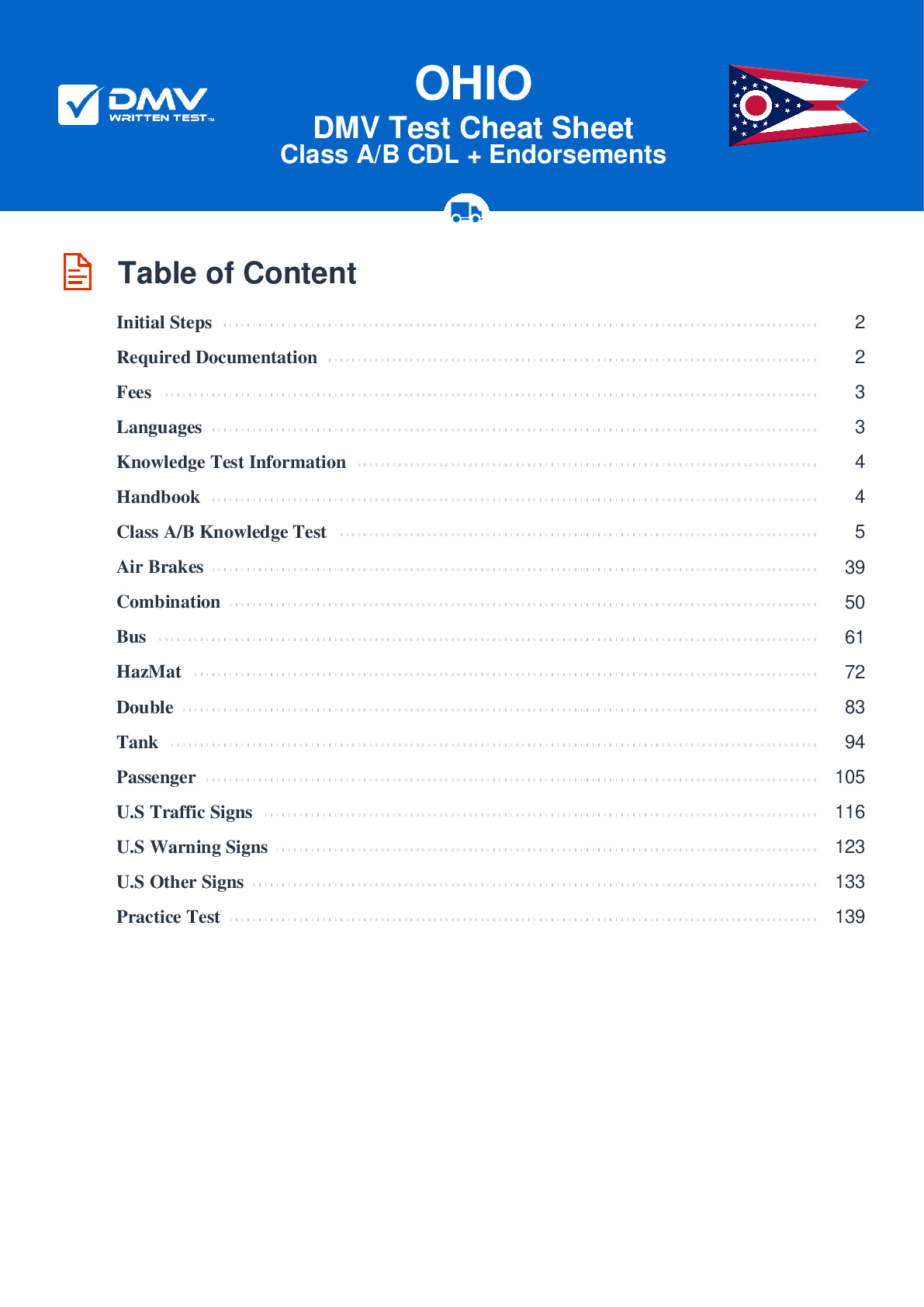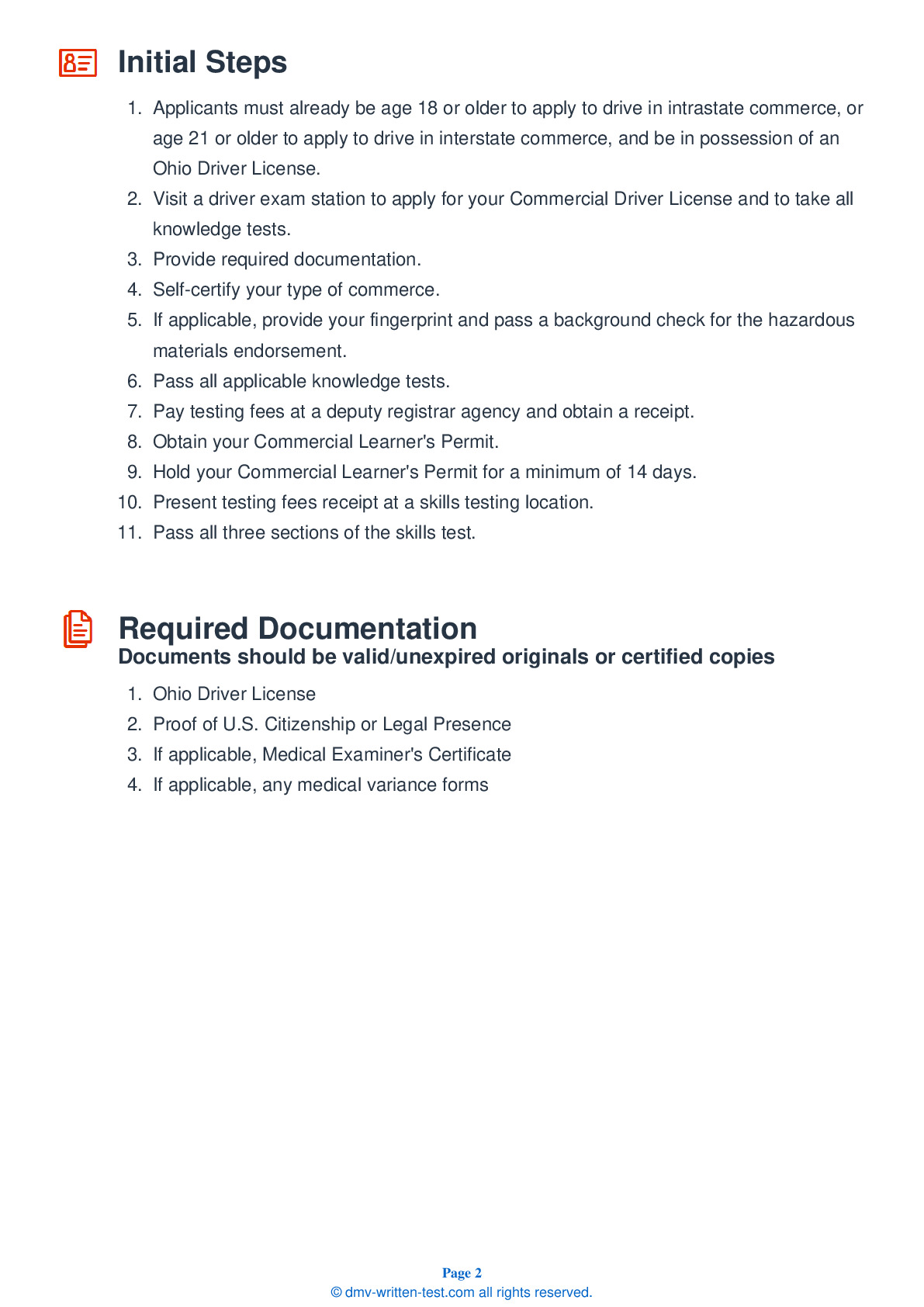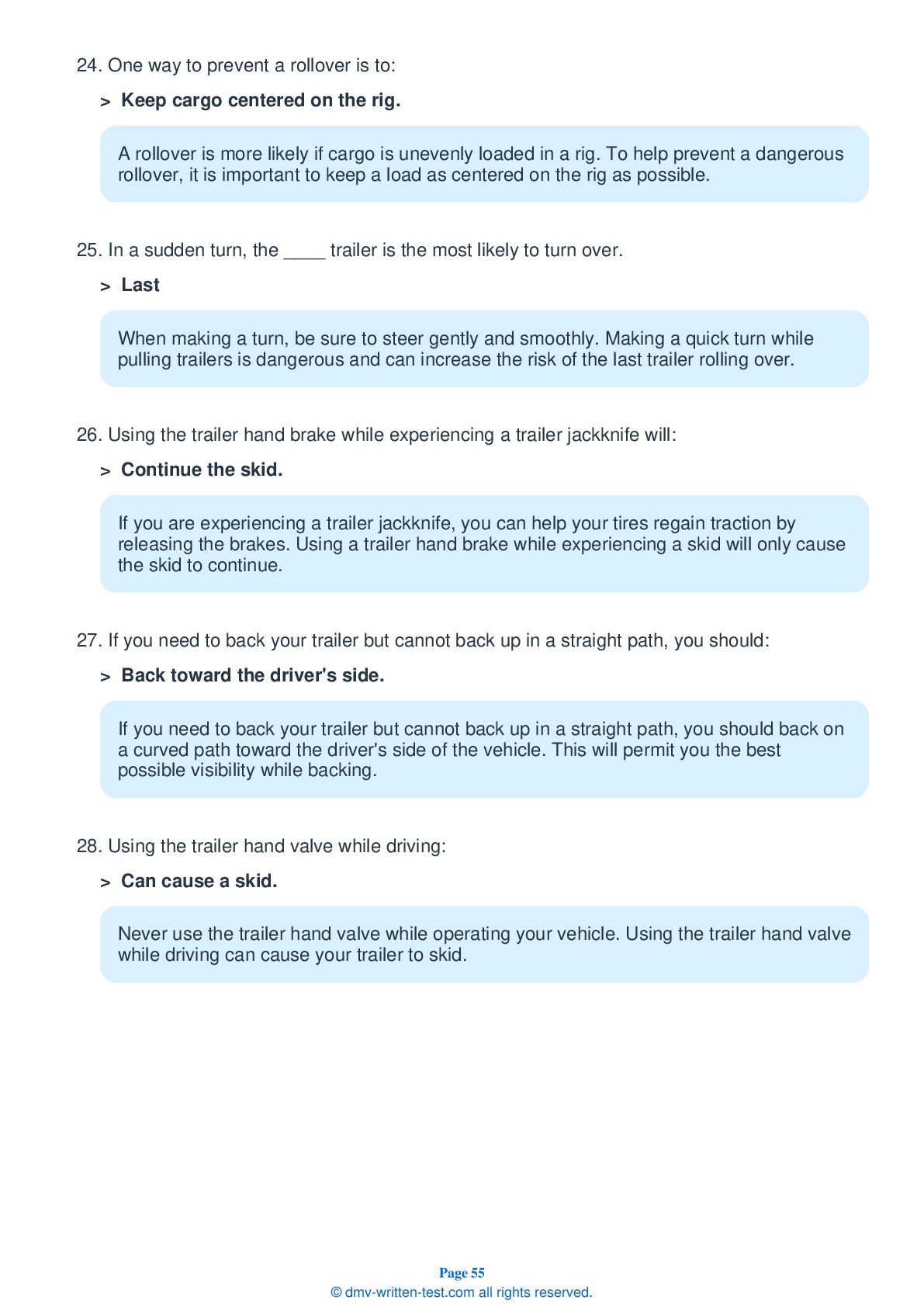Knowledge Test Class B
This license is required for driving a single vehicle with a GVWR of more than 26,001 pounds, and a trailer not to exceed 10,000 pounds gross vehicle weight rating, or a vehicle designed to transport 24 or more people (including the driver). To receive this license, applicants must pass a 50-question test. To pass, applicants must answer 40 questions correctly. Test questions come from the Ohio Commercial Driver’s License Manual. Questions come from chapters covering: Introduction, Driving Safely, Transporting Cargo Safely, Air Brakes (if applicable), Pre-Trip Vehicle Inspection Test, Basic Vehicle Control Skills Test and On-Road Driving.. Endorsements that may be used with a Class B CDL are: Hazardous materials, Tank, Passenger, HazMat and Tank, Air Brakes and School bus.
29. During the vehicle inspection test, you will be asked to:
During the vehicle inspection test, you will be asked to do a complete inspection of your vehicle. You will need to explain what you are inspecting and why.
30. To check the automatic transmission fluid level in some vehicles, you will have to:
In some vehicles, it may be necessary to leave the engine running when checking the automatic transmission fluid level.
31. When experiencing cold weather, be sure to check your vehicle's alcohol evaporator:
An alcohol evaporator can help prevent ice from building up in an air brake system. In cold weather, the evaporator should be checked and refilled every day.
32. What is the best way to stop if your brakes fail while you are driving downhill?
If your brakes fail on a downgrade, you will need to quickly find something outside that can stop your vehicle. An escape ramp is the best option. If no escape ramp is available, use the least hazardous available option, such as driving into an open field or side road that flattens out or turns uphill.
33. An alcohol evaporator in an air brake system:
Some air brake systems include an evaporator that introduces alcohol into the system. The alcohol can help prevent ice from forming within the system.
34. When performing a pre-trip inspection and looking into the fifth wheel gap, you should:
When inspecting a tractor/trailer coupling, look into the fifth wheel gap and make sure the locking jaws are fully closed around the kingpin.
35. A driver who stops at a green light could be:
It is important to observe other drivers' actions and identify clues that a person could be driving impaired. Drivers who have had too much to drink, are sleepy, are on drugs, or are ill can present hazards to other drivers. One sign that a driver may be impaired is that they stop in inappropriate places, such as at green traffic lights.
Frequently Asked Questions
Here are the steps to obtain a Class B CDL license in Ohio:
1. Obtain and review the Ohio CDL Handbook: The Ohio CDL Handbook contains information about the requirements for obtaining a CDL in Ohio, as well as rules and regulations that apply to commercial drivers.
2. Obtain a learner's permit: Before you can obtain a Class B CDL in Ohio, you must first obtain a learner's permit. To do this, you must pass a written knowledge test and a vision test.
3. Practice driving: Once you have your learner's permit, you can start practicing driving with someone who has a valid CDL license.
4. Pass the skills test: The skills test includes three parts: pre-trip inspection, basic vehicle control, and on-road driving. You must pass all three parts of the skills test to obtain your Class B CDL license.
5. Provide required documents: You will need to provide proof of identity and residency in Ohio, as well as your Social Security number.
6. Pay the fee: You will need to pay the required fee to obtain your Class B CDL license in Ohio.
7. Maintain your license: Once you have your Class B CDL license in Ohio, you will need to maintain it by renewing it every four years and following all applicable rules and regulations for commercial drivers.
Some examples of vehicles you may be authorized to operate with a Class B CDL license include:
- Straight trucks: These are trucks with a cab and cargo area on the same chassis, such as delivery trucks and dump trucks.
- Large buses: This includes buses designed to transport 16 or more passengers.
- Box trucks: These are large enclosed trucks used for moving cargo.
- Tow trucks: This includes vehicles used for towing other cars, such as flatbed tow trucks.
It is important to note that there may be additional endorsements required to operate certain types of vehicles, such as school buses or vehicles carrying hazardous materials. Make sure to check the Ohio CDL Handbook for specific requirements.
1. Meet the age requirement: You must be at least 18 years old to obtain a Class B CDL license in Ohio. However, if you plan on operating a commercial vehicle across state lines or transporting hazardous materials, you must be at least 21 years old.
2. Obtain a valid Ohio driver's license: You must have a valid Ohio driver's license before you can apply for a CDL.
3. Obtain a learner's permit: To obtain a learner's permit, you must pass a written knowledge test and a vision test.
4. Pass the skills test: To obtain your Class B CDL license in Ohio, you must pass a skills test that includes three parts: pre-trip inspection, basic vehicle control, and on-road driving.
5. Provide required documents: You will need to provide proof of identity and residency in Ohio, as well as your Social Security number.
6. Meet medical requirements: You will need to pass a medical examination and obtain a medical certificate from a qualified medical examiner.
7. Pay the fee: You will need to pay the required fee to obtain your Class B CDL license in Ohio.
It is important to note that there may be additional requirements or endorsements needed depending on the type of vehicle you plan to operate with your Class B CDL license. Make sure to check the Ohio CDL Handbook for specific requirements and endorsements.
If you are under 21 years old, you are not allowed to:
- Transport hazardous materials
- Operate a commercial vehicle outside of Ohio
- Operate a commercial vehicle with more than one trailer
- Transport passengers outside of Ohio
If you are 21 years old or older, you can operate a commercial vehicle across state lines and transport hazardous materials.
Keep in mind that individual employers may have their own age requirements for certain driving positions, so it's important to check with them as well.
1. Passenger endorsement (P): If you plan on driving a commercial vehicle designed to transport 16 or more passengers, including the driver, you must obtain a passenger endorsement.
2. School bus endorsement (S): If you plan on driving a school bus, you must obtain a school bus endorsement.
3. Tanker endorsement (N): If you plan on hauling liquids or gases in bulk containers with a capacity of 1,000 gallons or more, you must obtain a tanker endorsement.
4. Hazardous materials endorsement (H): If you plan on transporting hazardous materials, as defined by federal regulations, you must obtain a hazardous materials endorsement.
To obtain these endorsements, you will need to pass additional knowledge and skills tests beyond the basic CDL skills test. The requirements for each endorsement can vary, so it's important to check the Ohio CDL Handbook for specific information on each one.
1. Pre-trip inspection: Before starting the vehicle, you will need to conduct a thorough inspection of the vehicle and explain to the examiner what you are checking for. You will need to identify any potential safety hazards or defects.
2. Basic vehicle control: You will be tested on your ability to control the vehicle in a closed course setting. This includes straight line backing, offset backing, and parallel parking.
3. On-road driving: You will be tested on your ability to safely operate the vehicle in traffic, including obeying traffic signals and signs, merging onto highways, and passing other vehicles.
4. Special skills: If you plan on obtaining certain endorsements, such as a passenger or school bus endorsement, you may need to complete additional special skills tests that are specific to those types of vehicles.
During the skills test, you will be evaluated on your ability to perform each task safely and effectively. It's important to practice and prepare for the skills test by reviewing the Ohio CDL Handbook and getting plenty of hands-on practice with a qualified instructor or mentor.
1. Vehicle weight: Drivers with a Class B CDL are licensed to operate single vehicles with a gross vehicle weight rating (GVWR) of 26,001 pounds or more, or any such vehicle towing a trailer with a GVWR of less than 10,000 pounds.
2. Passenger limitations: Drivers with a Class B CDL may transport up to 16 passengers, including the driver, in a vehicle designed to transport passengers.
3. Endorsements: Depending on the type of vehicle you plan to operate, you may need to obtain additional endorsements on your CDL. For example, if you plan to transport hazardous materials, you will need to obtain a hazardous materials endorsement.
4. Time limitations: Under federal law, drivers with a Class B CDL are limited to driving no more than 11 hours in a 24-hour period and no more than 14 hours in a row. They must also take at least a 30-minute break after driving for 8 hours.
5. Medical requirements: Drivers with a Class B CDL must undergo regular medical exams and meet certain health requirements in order to maintain their license.
It's important to be aware of these restrictions and limitations in order to ensure that you are operating your commercial vehicle safely and within the bounds of the law.
If you need to take the written test in a language other than English, you will need to request a translator or an interpreter when scheduling your test appointment. The Ohio Bureau of Motor Vehicles (BMV) provides translation and interpretation services for a fee.
It's important to note that even if you take the written test in another language, you will still need to have a basic understanding of English in order to communicate with law enforcement officers and other officials while operating your commercial vehicle. Additionally, all road signs and signals are in English, so it's important to be able to read and understand them in order to operate your vehicle safely.
To request accommodations for the CDL written test, you will need to contact the BMV's Commercial Driver License Section and provide documentation of your disability and the specific accommodations you need. Some examples of accommodations that may be provided include extended testing time, a separate testing room, or a sign language interpreter.
It's important to note that you will need to request accommodations in advance, as it may take some time to arrange for them. Additionally, you will still be required to meet the same standards as other CDL applicants and pass the same tests. The accommodations are simply meant to ensure that you have an equal opportunity to demonstrate your knowledge and skills.
In Ohio, you are allowed to retake the CDL written test one time within a 24-hour period. If you fail the test a second time, you will need to wait at least seven days before retaking it again. If you fail the test three or more times, you will need to wait at least 30 days before retaking it again.
It's important to note that each time you retake the test, you will need to pay a fee. Additionally, it's a good idea to study and prepare thoroughly before retaking the test. You may want to review the Ohio CDL manual and take practice tests to identify areas where you need additional study and practice.
If you have failed the CDL written test multiple times and are struggling to pass, you may want to consider enrolling in a CDL training program or working with a CDL instructor to improve your knowledge and skills.




